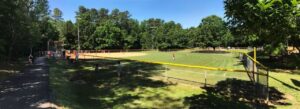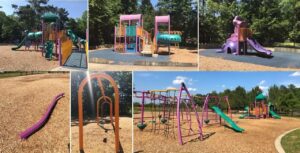(PCC) Program on Chinese Cities – Thoughts on Overseas Travels Series
Authors: Wanfei Gao,
faculty member at the School of Civil and Architectural Engineering, Xi’an University of Technology, and a visiting scholar at UNC, specializes in urban and rural planning and theory. Email: gaowanfei@xaut.edu.cn
Children have the right to ample play and recreation, and all forms of games and entertainment must share a unified purpose with education. It is the duty of society and relevant authorities to promote this right.
— Geneva Declaration of the Rights of the Child
We don’t stop playing because we grow old; we grow old because we stop playing.
— George Bernard Shaw
Having spent some time at the University of North Carolina at Chapel Hill, I have visited several major cities on the East Coast and gained various direct experiences with American cities. One notable observation is the emphasis placed on children, from national protection policies to the minutiae within cities that cater to children’s development at all stages.
Outdoor activities play a crucial role in children’s healthy growth. Children need to play freely outdoors, engaging in repetitive exercises to develop skills such as athletics, perception, attention, memory, problem-solving, language, social interaction, and creativity. Outdoor play is a vital method for children to explore the world, offering diverse ways and catering to different developmental stages. For instance, a three-year-old might need grassy slopes for rolling, tunnels for crawling, uneven steps, circular tricycle tracks, climbing structures, enclosed areas, and simple sports activities targeting objects. They might engage in playing with sand, picking plants, doodling, and building with blocks. A four-year-old requires activities that improve balance, spatial awareness, jumping, dodging obstacles, and cooperation with peers. Older children might participate in hiking, biking, picnicking, and forest adventures.
Two primary factors affecting children’s use of outdoor spaces are independence in activities and safety. Children prefer open, colorful, and diverse playgrounds that integrate learning through play, relieve psychological stress, and offer direct interactions with nature. Common outdoor settings in parks serve this purpose (see Figure 1).

Near downtown Chapel Hill, there are many outdoor venues for children, complete with extensive soccer and baseball fields integrated with parks and green spaces, providing a beautiful and safe environment. Children often engage in organized activities during weekends, accompanied by parents and professional coaches, with parks filled with applause and cheers (see Figures 2 and 3).


Many community parks feature open playgrounds that combine play equipment, fences, and flooring in a traditional layout. The equipment is carefully designed to develop various skills; fences somewhat restrict children’s range of activity while ensuring their safety; and flooring typically involves rubber or elastic tiles, with Chapel Hill’s playgrounds often using wood chips for their slip-resistant and cushioning properties (see Figure 4).

Play equipment is usually set up in large green spaces or forests, designed to be colorful and surrounded by pleasant greenery, making them natural and engaging (see Figure 5). Parks also feature large lawns, sandboxes, small ponds, and sculptures that enhance spatial awareness, all ideal for children’s play (see Figure 6).


Children’s growth should not be detached from nature or its elements. Rich outdoor play spaces always bring fresh and joyful experiences to children; by using colors, textures, and forms, they facilitate interaction with the environment. Well-designed outdoor play spaces are crucial for enhancing cognitive abilities, intelligence, physical health, and personality development. The U.S. carefully considers the safety of children’s activity areas, avoiding hard surfaces like asphalt, concrete, and gravel in favor of soft materials with a minimum depth of 12 inches (about 30 cm), extending beyond the equipment’s use area, and maintaining all children’s activity spaces. Although the U.S. lacks comprehensive safety standards for children’s playgrounds, national consensus standards based on public playground accident experiences guide the construction and maintenance of recreational facilities. Parents can choose clean, safe, and green playgrounds based on their child’s age. The distribution, setup, and management of American children’s playgrounds are exemplary and worth emulating.
